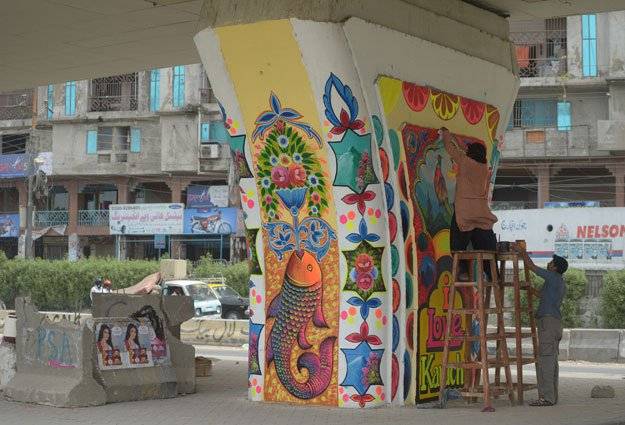As Sharmeen Obaid Chinoy took the Oscar stage for the second time and lifted that coveted golden statue, one wonders why there aren’t more of us like Sharmeen who dare to use the art form to convey what is important and bring the much needed change in society. While your conservative Pakistani (cue to certain religious political party chief) might argue that film, television and music are a “fahaash” or against religious and moral values, the impact that such film and television series are creating, is testament of their importance. Maybe this certain individual would learn a thing or two about humanity and courage if he had taken the liberty of actually watching the harrowing documentary on honor killing made by Ms. Chinoy. But then again expectations should be manageable and empathy cannot be expected from those who have none to give. This begs to ask the question, why aren’t we integrating the arts into the upbringing of our children and in society with the passion that it deserves instead of dismissing it as a frivolous activity?
A recent discussion in the classroom on the importance of the arts and various art forms led me to some interesting opinions voiced by my students. I asked them to say the first word that comes to their mind when they hear the words “The Arts”. Amongst words like, “music, dance, painting”, were the words, “men in tights” or “pansies”. It does not require an explanation to see what the problem is here. Ignorance is not the students fault, it is the educators, the government and the social setting that has presented a skewed understanding of what art is and dismissed it as a transgression from the norm. The words Liberal Arts was derived from the Latin word, liberalis, which means “worthy of a free person”. The arts is the integration of many disciplines of social sciences, from theology and philosophy to fine arts, all of which are given too little importance in the Pakistani society.
An article in the Scientific American published by the title, “Why Scientists should embrace the liberal arts” makes an excellent observation. It points out and rightly so, that science has two important yields: increased understanding of the world within and around us as well as solutions to specific problems. But even the most profound scientific knowledge won’t solve world problems such as hunger, poverty and environmental damage if we fail to respect, understand and engage cultural differences. More and more universities and think tanks are carrying out inter disciplinary research because they have understood that isolating problems to calculate their scientific perspective is simply not enough to find a solution. To cite an example, science may have discovered the vaccine for polio, but an understanding of fears, reservations and cultural and religious misgivings is essential to administer the vaccine to the public effectively.
Arts education has always been a contested area even in the US. Arts educators like EB Feldman, have defended the arts in the school curriculum by accentuating their role in students’ moral and individual development. In the 80s he argued that arts education could infuse in young people a sense of the satisfaction that comes from working to create something and ultimately a profound sense of ‘the values that permit civilised life to go on’. Twentieth-century German philosopher Ernst Cassirer explained the importance of the arts in the following words, ‘Science gives us order in thoughts, morality gives us order in actions; art gives us order in the apprehension of visible, tangible and audible appearances.’ A holistic education includes a decent amount of focus on arts education, introducing children and young people to great literature (novels, poetry and short stories, plays), dance, visual arts, music and film. Unfortunately all education programs are resource intensive and funding for arts programs have been cut many a times in the US, sparking much debate on why arts deserves equal importance to core subjects as well as public money.
What Pakistani parents must realise is, before they hastily forbid their children from taking part in the school play, that students who study the arts will not necessarily become artists, while the handful of those who do will specialise in one artform. So the purpose of a good arts education must primarily be to develop the ability to judge, ideally within a range of forms. Art has great potential to be used as a learning tool; music notes can be used to teach fractions, play writing can develop language skills… the applications are limitless. If we want to raise citizens that understand civic responsibility, are socially aware and are empathetic, considerate human beings, we must stop shunning the arts and encourage our children to appreciate the deeper forms of beauty across all disciplines.
Saturday, November 23, 2024
The liberal arts

The writer is a member of staff
Country reports two new polio cases in D I Khan, raising tally to 52
November 23, 2024
7 terrorists killed in Balochistan, KP operations: ISPR
November 23, 2024
Playing religion card for petty gains!
November 23, 2024
Gandapur declared Proclaimed Offender by Anti-Terrorism Court
November 23, 2024
PTI keeps PPP, PML-N united
November 23, 2024
-
Digital nomadism redefines work and travel across the globe
-
Digital nomadism redefines work and travel across the globe
-
Lahore tops global pollution rankings as smog worsens, AQI reaches hazardous levels
-
Hunger crisis to increase in South Sudan, warns UN
-
Pakistan’s judiciary champions climate justice at COP29 in Baku
-
Punjab struggles with persistent smog as Met Office forecast rainfall
Paper Justice
November 23, 2024
No Silver Bullet
November 23, 2024
Reckless Accusations
November 23, 2024
UN Crossroads
November 22, 2024
Smog Trade-off
November 22, 2024
The World: No Longer Livable
November 23, 2024
Unveiling Protein Secrets with AI
November 23, 2024
Outdated Policy
November 23, 2024
Brain Drain
November 23, 2024
Proposal to counter increasing cases of harassment
November 22, 2024
ePaper - Nawaiwaqt
Nawaiwaqt Group | Copyright © 2024





